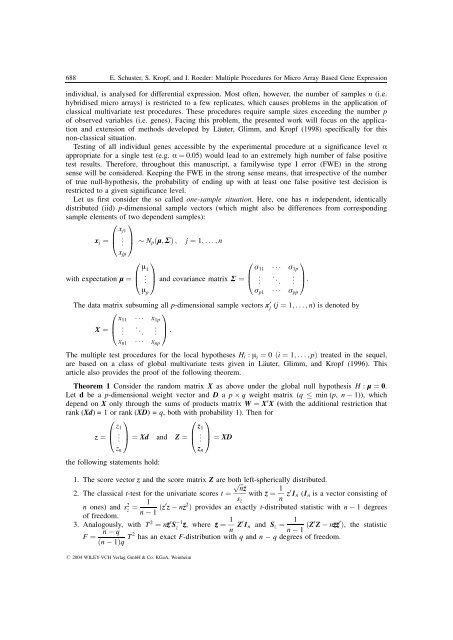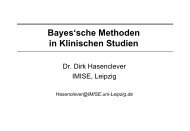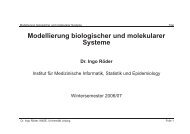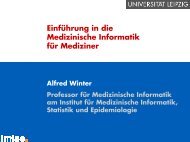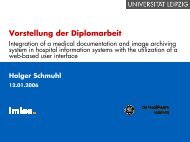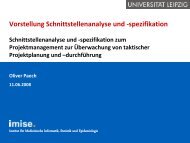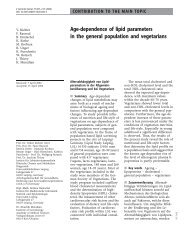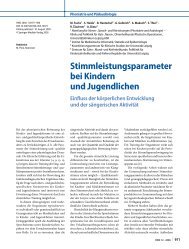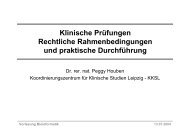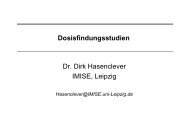Download (200 kB, 12 pages)
Download (200 kB, 12 pages)
Download (200 kB, 12 pages)
You also want an ePaper? Increase the reach of your titles
YUMPU automatically turns print PDFs into web optimized ePapers that Google loves.
688 E. Schuster, S. Kropf, and I. Roeder: Multiple Procedures for Micro Array Based Gene Expression<br />
individual, is analysed for differential expression. Most often, however, the number of samples n (i.e.<br />
hybridised micro arrays) is restricted to a few replicates, which causes problems in the application of<br />
classical multivariate test procedures. These procedures require sample sizes exceeding the number p<br />
of observed variables (i.e. genes). Facing this problem, the presented work will focus on the application<br />
and extension of methods developed by Låuter, Glimm, and Kropf (1998) specifically for this<br />
non-classical situation.<br />
Testing of all individual genes accessible by the experimental procedure at a significance level a<br />
appropriate for a single test (e.g. a ¼ 0.05) would lead to an extremely high number of false positive<br />
test results. Therefore, throughout this manuscript, a familywise type I error (FWE) in the strong<br />
sense will be considered. Keeping the FWE in the strong sense means, that irrespective of the number<br />
of true null-hypothesis, the probability of ending up with at least one false positive test decision is<br />
restricted to a given significance level.<br />
Let us first consider the so called one-sample situation. Here, one has n independent, identically<br />
distributed (iid) p-dimensional sample vectors (which might also be differences from corresponding<br />
sample elements of two dependent samples):<br />
0 1<br />
x j ¼<br />
B<br />
@<br />
x j1<br />
.<br />
.<br />
x jp<br />
C<br />
A N p ðm; SÞ ;<br />
0<br />
m 1<br />
B .<br />
with expectation m ¼ @<br />
m p<br />
1<br />
j ¼ 1; ...; n<br />
C<br />
A and covariance matrix S ¼<br />
0<br />
s 11 <br />
1<br />
s 1p<br />
B<br />
@<br />
. . . . . C<br />
A.<br />
s p1 s pp<br />
The data matrix subsuming all p-dimensional sample vectors x 0 j (j ¼ 1; ...; n) is denoted by<br />
0<br />
1<br />
x 11 x 1p<br />
B<br />
X ¼ @<br />
.<br />
.<br />
.<br />
. .<br />
.<br />
.<br />
C<br />
A :<br />
x n1 x np<br />
The multiple test procedures for the local hypotheses H i : m i ¼ 0 ði ¼ 1; ...; pÞ treated in the sequel,<br />
are based on a class of global multivariate tests given in Låuter, Glimm, and Kropf (1996). This<br />
article also provides the proof of the following theorem.<br />
Theorem 1 Consider the random matrix X as above under the global null hypothesis H : m ¼ 0.<br />
Let d be a p-dimensional weight vector and D a p q weight matrix (q min (p, n 1)), which<br />
depend on X only through the sums of products matrix W ¼ X 0 X (with the additional restriction that<br />
rank (Xd) = 1 or rank (XD) =q, both with probability 1). Then for<br />
0 1<br />
0 1<br />
z ¼<br />
B<br />
@<br />
z 1<br />
. .<br />
.<br />
C<br />
B<br />
A ¼ Xd and Z ¼ @<br />
z 1<br />
. .<br />
.<br />
C<br />
A ¼ XD<br />
z n<br />
the following statements hold:<br />
z n<br />
1. The score vector z and the score matrix Z are both pffiffiffi<br />
left-spherically distributed.<br />
n z<br />
2. The classical t-test for the univariate scores t ¼ with z ¼ 1 s z n z0 1 n (1 n is a vector consisting of<br />
n ones) and s 2 z ¼ 1<br />
n 1 ðz0 z nz 2 Þ provides an exactly t-distributed statistic with n 1 degrees<br />
of freedom.<br />
3. Analogously, with T 2 ¼ nz 0 Sz 1 z, where z ¼ 1 n Z0 1 n and S z ¼ 1<br />
n 1 ðZ0 Z nzz 0 Þ, the statistic<br />
F ¼ n q<br />
ðn 1Þq T2 has an exact F-distribution with q and n – q degrees of freedom.<br />
# <strong>200</strong>4 WILEY-VCH Verlag GmbH & Co. KGaA, Weinheim


